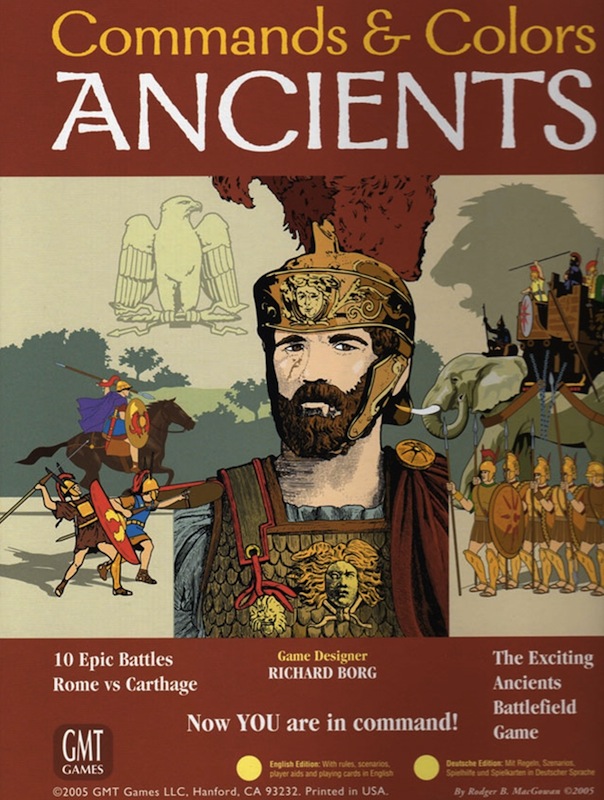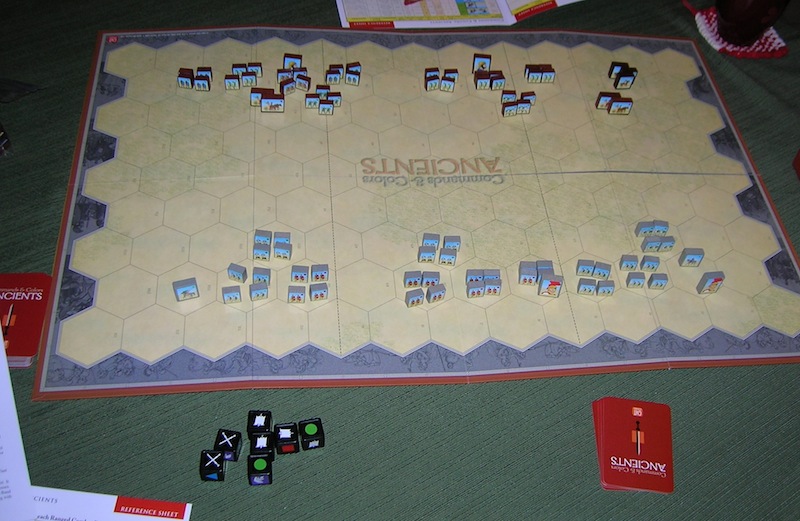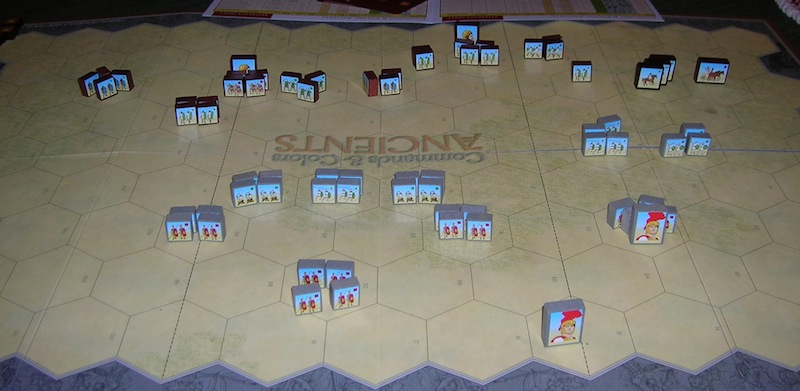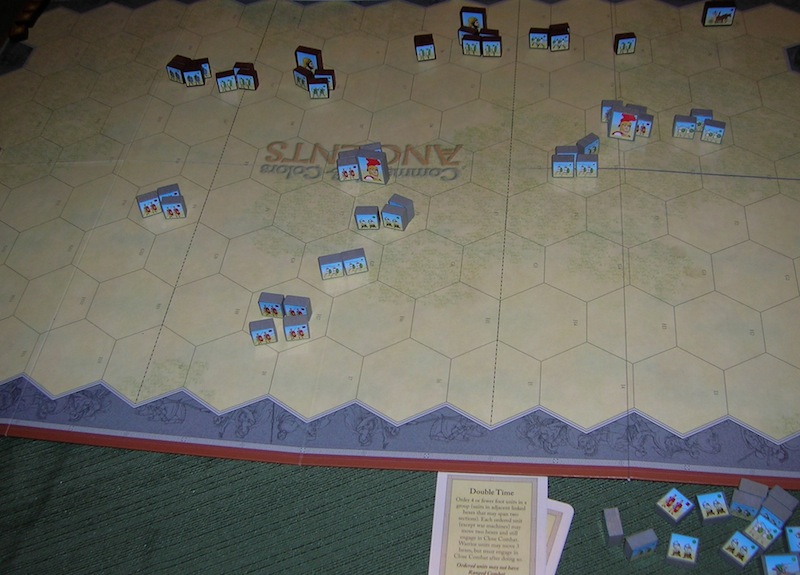Let Your Grog Flag Fly!
Recent Articles
GARPA 17, 4/26/13
SimCity AAR Part 1, 4/25/13
Announcing MayViation, 4/24/13
Second Look at Wargame AirLand Battle, 4/21/13
First Look at Wargame AirLand Battle 4/19/13
AAR of Dark Age Minis Battle, 4/18/13
Video Review of Zulus on the Ramparts, 4/14/13
GARPA 16, 4/12/13
Crusader Kings II AAR Part 16, 4/11/13
Book Review: Ninja: 1000 Years of the Shadow Warrior, 4/10/13
Review of Bioshock INfinite, 4/7/13
Review of XFX PRO650W Core Edition PSU, 4/5/13
Civilization V AAR, Part 13, 4/4/13
Fire with Fire, 3/31/13
GARPA 15, 3/29/13
Civilization V AAR, Part 12, 3/28/13
Wheaton INterview, 3/27/13
March Mayhem Winner, 3/25/13
Warlock Multiplayer AAR, 3/21/13
WWII PTO Alternate Histories, 3/20/13
GARPA 14, 3/15/13
Crusader Kings II AAR, part 15, 3/14/13
Civilization V AAR, part 11, 3/7/13
Prezcon Convention Coverage, 3/2/13
Civilization V AAR, part 10, 3/3/13
Click here for our
FULL Article Index
and
Screenshot features |
Commands & Colors Ancients Boardgame
Review
by Dan Pinkham, 18 April 2012
Designed by Richard Borg for GMT Games
Unleash the armies of Rome and Carthage upon your dining room tables, albeit with much less sand and blood than their historical counterparts.
Introduction
Commands & Colors Ancients, the ancients boardgame from GMT Games, brings the armed conflict between the Romans and Carthaginians to life on your tabletop. Designed by Richard Borg of Battle Cry and Memoir ’44 fame Commands & Colors Ancients continues to build on the concept of the “command card system.” The Commands & Colors Ancients game is the base of GMT Games’ series that allows you to delve into ancient warfare on your gaming table. This block wargame was designed with two players in mind but there is a variant for solo play to be found online. Most scenarios should be able to be played in about one hour, however expect to spend some time assembling the game before jumping into your first gaming session.

Components
The first thing I noticed when picking up my copy of Command & Colors Ancients is how heavy the box is. This has something to do with the bag of 345 gray, brown and black wooden blocks representing the Roman and Carthaginian units, and victory blocks respectively. To go with the blocks are five pages of stickers representing the various units used in the game, all of which must be affixed to the front and back of their corresponding block. Along with the blocks and their stickers are seven large black battle dice that need their corresponding stickers attached to their six sides. The game board is a double-sided hex-tiled battlefield representing a flat and barren landscape. One side of the game board is missing one of the short edges border in order to combine multiple boards to play larger scenarios. To help spruce up the barren battlefield the game contains 45 double-sided terrain tiles; including broken ground, forest, hill, fortification and water feature tiles. A set of 60 command cards are also included. At the bottom of the box you also find the ‘Core Series Rule Book,’ scenario book, and two quick reference cards.
This brings me to the first downside to the game. You should be aware that before being able to jump into the game some assembly is required. Most of the 345 blocks need to have a sticker put on their front and back faces before you can begin to play. The rule book gives you a couple tips for this process as well as the number of each block you should have when you are all finished. The seven dice also need stickers attached to them and the terrain hexes will need to be punched out of their sheets. I found using small sandwich bags to keep the different tiles separate was an easy way to organize all the unit blocks during and after the assembly process.

The quality of the game components overall is very good. The blocks are solid and unless you have a nervous habit of picking at the things the stickers will stay securely attached. The unit art on the stickers are simplistic but effective albeit a bit hard to see at a distance, especially the unit symbols. The board and hex tiles are made of quality cardboard with good artwork. The deck of cards is sturdy and should withstand many a gaming session unless you are a particularly violent shuffler. The rule and scenario books are printed well and are helpful using diagrams when called for. I found the two quick reference cards particularly helpful especially in the heat of battle. They are actually two cardstock pages of charts pertaining to combat, movement, and the command cards. I have to say how pleased I am that these are included as they ensure both players have access to the most important information needed to play the game. The only component’s quality I was truly disappointed in was the seven battle dice. They are quite a bit larger than your standard six-sided dice and are made of a hard black plastic. They look out of place alongside of the other game components and do not roll particularly well if there is not much room for dice chucking. A nice set of standard size tan or wooden dice with the appropriate symbols on them would have fit in well with the style of the rest of the components.

Gameplay and Mechanics
The Commands & Colors rule book is only 24 pages long with the rules presented in a very straight forward and common sense way. The first scenario in the scenario book is a great way to ease into the game and is recommend to be played first. As mentioned before, the game is a command card driven system. Depending on the scenario each player is assigned a specified number of command cards for their hand throughout the battle. There cards are divided into four categories: sections cards, troop cards, leadership cards and tactic cards. The battlefield board is divided into the three sections; left, center, and right. The section cards allow you to order a number of units in a specific section or sections, while the troop cards allow you to order a specific type of unit. Leadership cards allow special actions by leaders assigned to your command and tactic cards allow special formations, tactical maneuvers, or attacks to be performed.

Units are composed of a set number of blocks in a single hex and are divided into foot and mounted units. Foot units include light, medium, and heavy infantry, bow, slinger, auxiliary, and warrior units. Mounted units include light, medium, and heavy cavalry, chariot, and elephant units. Each side is also assigned one to three leader unit blocks. Each type of unit has a symbol associated with it which is portrayed, along with the unit artwork, on the sticker. These symbols help identify unit type and streamline combat even if they are somewhat hard to differentiate from a distance. The only drawback to the units is the lack of diversity between the two nations’ unit types. Both sides utilize the same unit types which are only differentiated by the unit artwork depending on whether the unit is Roman or Carthaginian. That being said I believe this works within this game as adding too many different unit types and their varying capabilities, depending on nationality, would take away from the ease of play and flow of the game.
The game play then is very intuitive, and if you have ever played Memoir ’44 you will be familiar with it; if not you will catch on quickly. Each game turn the player picks a command card to play from their hand, orders the corresponding units, moves the units, battles and then draws a new command card. The challenge comes in selecting the best command card and synchronizing the movements and attacks of your units over several turns using a combination of command cards. I quickly learned that while the basics of gameplay come easy it is much more difficult to coordinate a plan of attack while limited to the command cards in your hand.
The game moves along at a good pace with combat being quick and bloody when opposing forces make contact. One of the features I like in close combat is called “battle back.” After an attack is made, if the defender has survived and is not forced to retreat he is allowed to ‘battle back’ against the attacker possibly inflicting causalities or forcing the attacker to retreat. This feature can have a big impact on combat adding another dimension to planning by the attacker and defender.

Another gameplay nuance of the game not to be overlooked is the leader block. The leaders can improve combat power, boost morale, allow momentum advance and provide benefits to movement of nearby units when certain command cards are played. The proper use of leaders combined with the coordinated movement of one’s units can be decisive in a battle of Commands & Colors Ancients. Scenarios are then won by taking a scenario-determined number of victory banners, acquired by killing enemy units or taking scenario objectives.
Conclusion
Commands & Colors Ancients ends up being a great light ancients wargame. The easy to understand but hard to master command card system allows the player to easily learn the rules and jump into the game. However, the game also offers a challenge in terms of implementing a sound and effective strategy within the confines of that command card system. With the exception of the combat dice and the time required to attach the stickers Commands & Colors Ancients is a solid wargame. Easy enough for someone just getting into or new to wargaming but with enough strategy for those grogs out there looking for a wargame that can be completed in an hour but still provide a challenge.
Grumpy Grog Says: This game will hit you like a Carthaginian war elephant. It might not have a lot of detail but there’s plenty of great gaming here.

Discuss it in our forums!
|
Please support the folks that support GrogHeads
|






